MAIN INDEX
STRAIGHT KEYS
J -5-A Flame Proof
J-37 "Mae-West"
J - 38 Lionel
JJ-38 Japanese Copy
J-41
J - 45 Leg Key
J - 46 (Hard to Find)
J - 47
J - 51
Navy Flame Proof
CAL-26012A Navy Key
Brelco Leg Key
AN/GSC-T1 Training Set
Bunnell Hand Key
J.H. Bunnell Mini-Key
1999 Vibroplex Hand Key
NYE 320-001 Hand Key
Signal Electric Spark Key
Bunnell No. 9 Westclox
Canadian No. 9 Westclox
Canadian Westclox Key
British Key WT 8 Amp
British R.A.F. "Bathtub"
Russian Military
Russian TKF Key & Filter
South African Army Key
German T-1
German Junker Key
GDR K-64 Hand Key
Wm. M. Nye Master Key
Speed-X 310 *
Polechanger Key
Hungarian Army Key
Dittmore Navy Key
Bulgarian Key
Czech Army Key
Vibroplex Code Mite
Kent Hand Key *
Toy Telegraph Set *
VIBROPLEX BUGS
1918 Wire Chief
Vertical
1922 Original
1942 Lightning Bug
1945 Lightning Bug
1946 Zephyr
1948 Original
1950 Blue Racer Deluxe
1954 Lightning Bug
1959 Original Deluxe
1960 Champion
1986 Original
1990 Original
1999 Blue Racer 2000
OTHER BUGS
Hi-Mound BK-100
E.F. Johnson 114-500
E.F. Johnson 114-520
Lionel J-36
PADDLES
1968 Vibroplex Deluxe
1972 Vibroplex Keyer
1987 Vibroplex Iambic
1999 Vibroplex
Square Racer
Ham-KEY Paddles
Bencher BY-1
Russian KEY-8 Keyer
Heath Kit Keyer
Homebrew Paddle
Paddlette PK-1
Autronic Paddle
Kent Twin Paddle
DUEL KEYS
RELAYS
J.H. Bunnell Relay
1844 to 1881
Signal Electric Relay
1881 to 1950
SOUNDERS
Western Electric
1905 to 1920
Electrical Supply Co.
1848 to 1881
Western Union
1860 to 1881
Foote-Pierson 15-B
J.H. Bunnell 15-C
Western Union 17-A
Western Electric 7-A
Unknown Sounder
Mesco KOB *
TELEGRAPH KEYS
RELAYS and SOUNDERS
J-5-A Flameproof Key
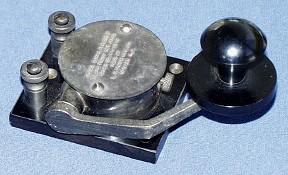
Signal Corps, U.S. Army, Flame Proof Key J-5-A, Circa 1941
Order No. 2670 NY 41, Made By L.S. Brach Mfg. Co., Newark N.J. The J-5-A, another good flameproof key from W.W.II. Setting the contact gap was accomplished by the adjustment screw just to the left of the knob skirt, shown in the photo above.
J-37 "Mae-West"
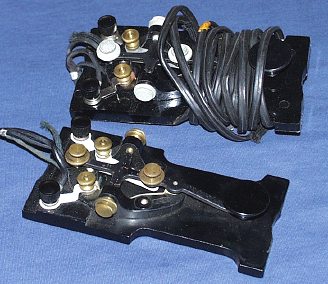
This is a classic J-37 key on a special base with indented
sides. The base was designed to allow the connecting cord to
be wrapped around the key so they could be stored in
the cover of a AN/GSC-T1 training set. This key
is sometimes referred to as a "Mae-West" or "Wasp-Waist"
Lionel J-38 Key
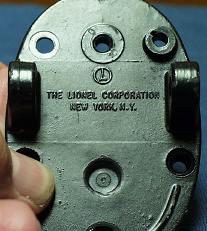
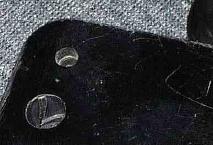
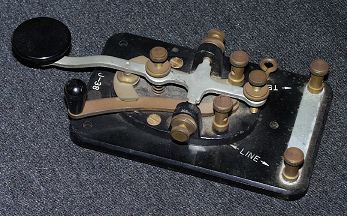
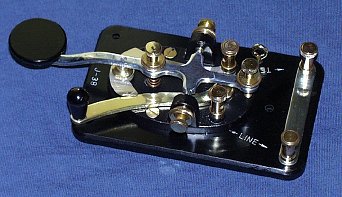
The J-38 was a general purpose "Triumph Style" key. It was made in great quantities during W.W.II. The J-38 was made by a wide variety of manufacturers including the Lionel Electric Company. The same company that made Lionel Toy Electric Trains.
The lower left photo shows the Lionel "L" logo stamped in the bottom of the base. Top left photo shows the Lionel name and logo on the top of the key base. Top right photo is key before cleaning, bottom right photo is key after cleaning.
JJ-38 Key
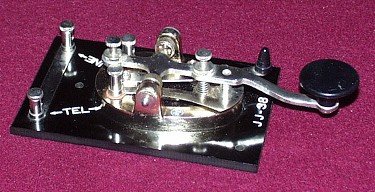
This is a Japanese copy of the original United States W.W.II era J-38 hand key. This JJ-38 uses the very common Japanese made ball-bearing copy of the Triumph style key. The base is made of black plastic. This key was not used as a military key.
J-41 Key

The J-41 is a standard J-37 key modified to include a set of normally closed contacts. This key was used in the U.S. Army TG-5 field telegraph sets.
J-45 Leg Key
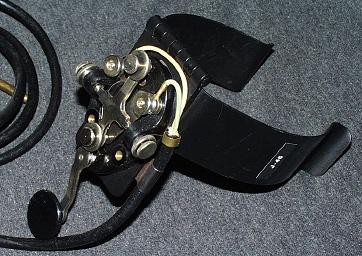
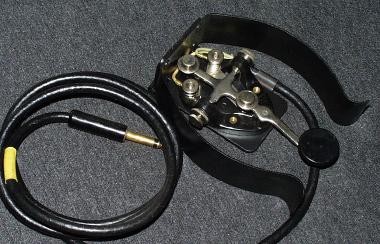
The J-45 leg key was made for use in aircraft and other military vehicles. It was clipped to the operators leg with the supplied leg clamp. The J-45 was made with a hinge so that the key could be folded into the leg clamp for easy storage.
J-46 Key
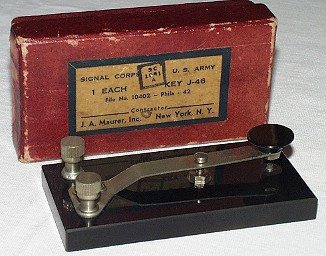
The J-46 is a strap key made by the J. A. Maurer company, and was used to key the EE-84 Signal Lamp Set. The EE-84 was used for sending light signals. J-46 keys are difficult to find, even more so in mint condition such as this one, . . . and with the original box.
J-47 Key
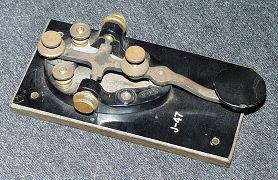
I've had this key since I was 15. It was given to me when I was in the Boy Scouts learning the Morse Code. The key is a J-37 mounted on what appears to be a black phenolic base. The base is stamped, J-47. I believe this key was made and used during W.W. II.
J-51 Key
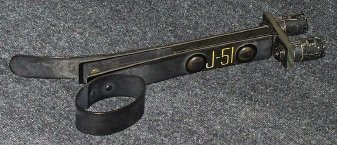
The J-51 is a rather interesting key. It was used to key the SE-11 Signal Lamp. Enemy soldiers would shoot at signal lamps in hopes of hitting the lamp and or the operator. This key was used with a long cord so the operator could be a safe distance away from the signal lamp while he was sending messages. The scissors type arrangment of this key makes it very different from other telegraph keys.
Navy Flameproof Key
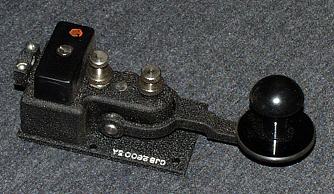
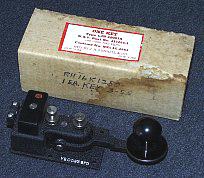
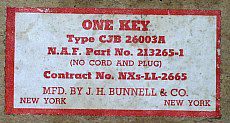
This Navy "Flameproof" key was made by J.H. Bunnell as indicated by the letters CJB on the key base. When I received this key it was still in the original box as seen below. *** My sincere thanks to Kevin, KG6D, for adding this key to my collection. ***
U.S. Navy Key CAL-26012
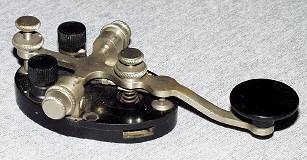
This Navy Key is a rather interesting key. The CAL part of the key number shows that this key was made by "Locke Insulator Co.". If you look carefully at the base of the key you will see a small slot just to the left of the contacts. This slot will accept the wedge connector of a J-36 bug. Once the J-36 wedge is plugged into this key, the J-36 could be used instead of the hand key.
Brelco Leg Key


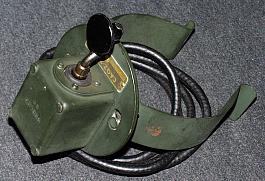
This key is marked with CAQZ-26026 which indicates that it was made by Brelco. This is also a "Flameproof" type key and was probably used in military aircraft and tanks with the provided leg clamp.
Code Training Set - AN/GSC-T1
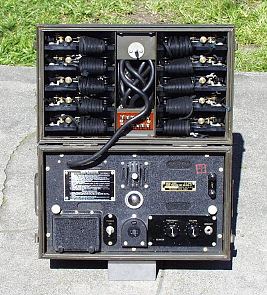

Text from Data Plate: SIGNAL CORPS U.S. ARMY CODE TRANING SET AN/GSC-T1 SERIAL No. 1798 ORDER No. 1046-PH-45-25 - Mc ELROY MFG. CORP. This U.S. Army Code Training Set has ten (10) J-37 keys mounted on special bakelite bases shaped to allow the cord to be wrapped around the key for storage. The T1 set provides for practicing transmission and reception of Morse signals, by both visual and audio methods. The AN/GSC-T1 can be powered by 6, 12, and 24 volts DC, as well as 115 volts DC or AC, and 230 volts AC. The ten keys are stored in the cover of the T1's case.
Bunnell Hand Key
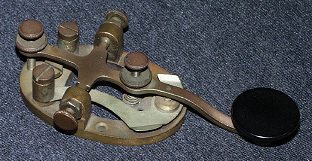
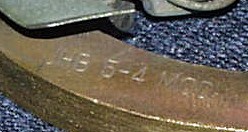
This is a Bunnell "Triumph Style" hand key. I got this key sometime during the late 60's. The only lettering on the key is, "JHB 5-4 MOD", on the top right side of the base near the contacts.
JHB Mini Key

This Bunnell mini key was made for use in a Western Electric Test Set. There were four of these keys to each test set, and each key was numbered on top of the key knob. This key is numbered "4". You can see just how small this key really is in comparison to the quarter in the photo.
1999 Vibroplex Deluxe Hand Key

This Vibroplex Deluxe Hand Key, S/N 105168, is very smooth in operation, and a pleasure to send with.
NYE 320-001 Key
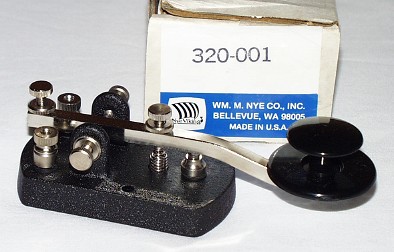
This well made hand key, model 320-001, is made by William M. Nye Co., Inc.
Signal Electric Co. - Brass Keys
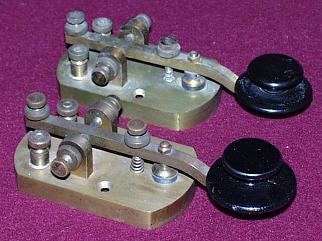
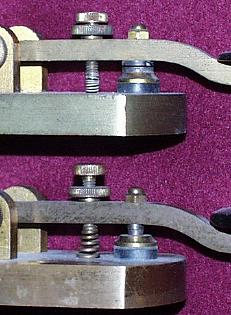
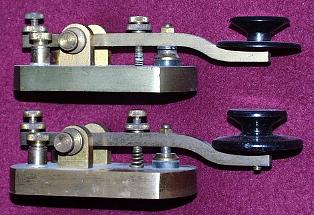
These two keys were made by the Signal Electric Company in large numbers from 1920 on. The early ones were made with larger contacts so they could be used with spark transmitters. The large contacts allowed the key to handle the high primary current of the spark transmitter. The top key in each photo above is a large contact spark key, and the bottom key is the standard wireless key. Notice the spark key has large 1/4" contacts whereas the standard wireless key has 1/8" contacts. Each key has a mica insulator under the brass base.
Bunnell No.9 / Westclox Key
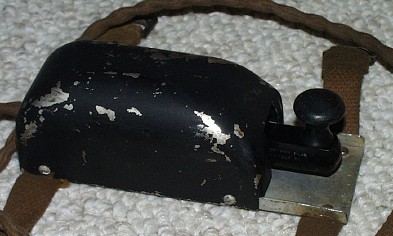
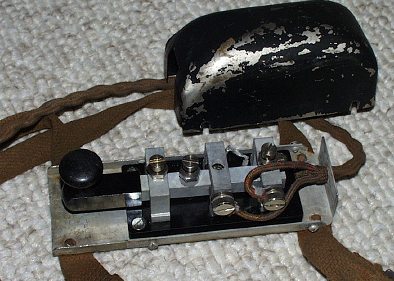
This key was manufactured by J.H. Bunnell Co., New York., probably for the British during W.W.II. The key is mounted on a base containing straps for holding the key to your leg. The base also has the following engraved in the area just under the key knob . . .KEY AND PLUG ASSEMBLY No. 9 CDN WESTCLOX
Canadian No.9 / Westclox Key
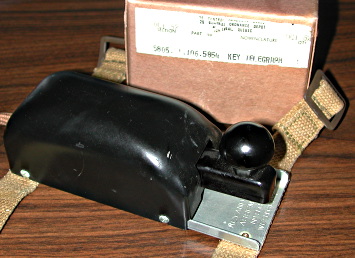
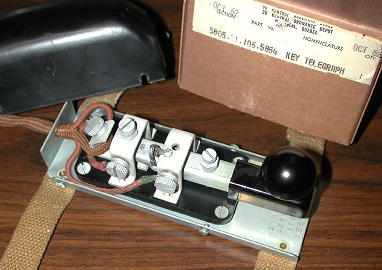
This key is slightly different than the No. 9 key manufactured by J.H. Bunnell Co., New York, also shown on these pages. I am not sure which company manufactured this key. The key is mounted on a base containing straps for holding the key to your leg. This key is in mint condition complete with the box. The base also has the following engraved in the area just under the key knob . . . KEY AND PLUG ASSEMBLY No. 9 CDN WESTCLOX
My thanks to Jack Hotchkiss W7CNL, for donating this key to my collection.
Westclox Key
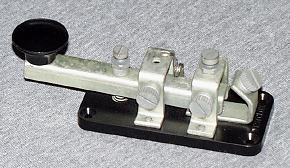
This is the Canadian version of the British WT-8A Key.
British Military WT-8 Amp Key

This English made key was used extensively by British Armed Forces during W.W.II The "Key, WT 8 Amp" was made in many different versions, and they are still readily available at swap meets and hamfests.
British R.A.F. "Bathtub Key"
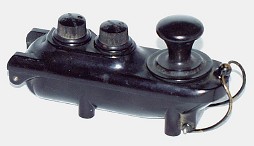

This key was used in British bombers during W.W.II. The metal ball and clip assembly, seen on the right side, is used to keep the top closed and can be pushed over the skirt of the knob to hold the key knob in the closed position. This kept the transmitter keyed after the radio operator bailed out of a badly damaged aircraft, and gave direction finders a constant signal so they could fix the position where the plane went down.
Russian Training Hand Key
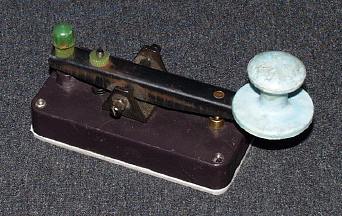
This key was recently given to me by my friend Stan, (UU5JZ K6WG) now R7KZ. I don't know much about its history. The base and several of the parts are made of plastic as you can see from the photo. I believe this key was made and used sometime after W.W. II for the Russian DOSAAF for code training and practice.
Soviet Military TKF Key & Filter
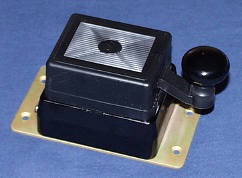
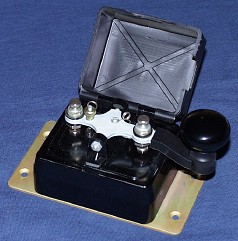
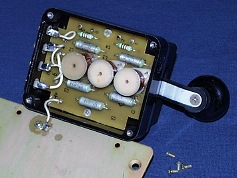
This key was made in CHERKASSY, UKRAINE for the Soviet military into the 1980's. The model TKF has an RF filter built into the base of the key which is designed to keep RF off the key line, and suppress arcing of the key contacts. The base of the key, excluding the metal mounting plate, is 3.5 by 3 inches.
South African Army Key
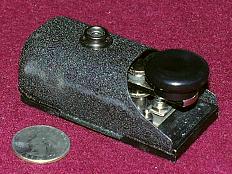
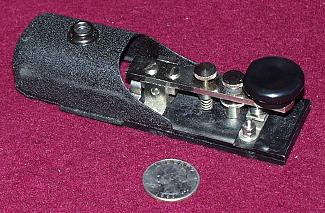
This small key was made in France for the South African Army. Cast into the plastic base is: "Ets G. JARDILLIER Ref:1955M". The cover slides open to gain access to the adjustments, and the snap on top is for a leg strap. You can see how small this key is in comparison to the quarter in the photo.
German T-1 Key
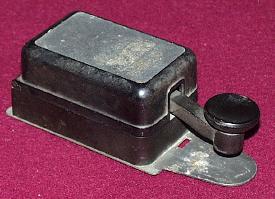
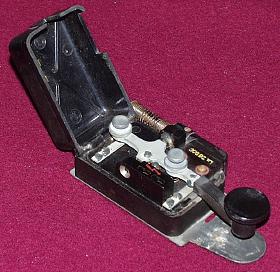
This old W.W.II German T-1 key is a pleasure to operate. Adjustments are easy to make and it has a very smooth feel while sending.
My first QSO using this key was with Bill W3IT on 20 meters, Feb 25, 2005.
German Junker Key
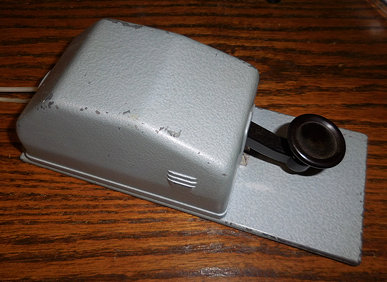
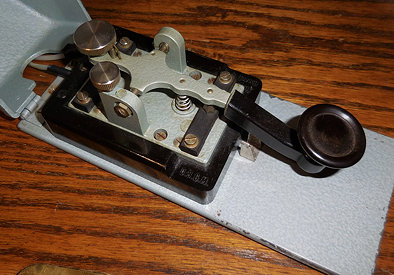
This German made Junker key is a post W.W.II model. It is a pleasure to send code with this key. Excellent workmanship and very precise adjustments make this key easy to use with a very smooth feel while sending.
My first QSO using this key was with Bernie KFØQS on 20 meters, Oct 30, 2019.
German Democratic Republic K-64 Key
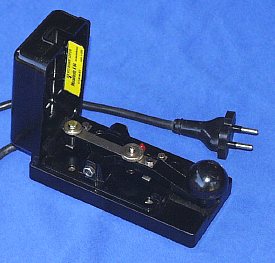

This key was made in the German Democratic Republic, probably in the 1970's to 80's.
Wm. M. Nye Master Key Model 330-001
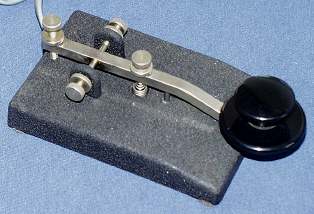
The Nye Master Key has an isolated contact assembly, (in the heavy base), so that the keying circuit is separated from the mechanical hardware.
Speed-X 310-003
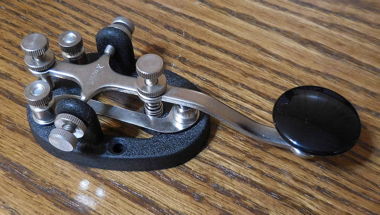
This Speed-X 310-003 key has the manufacture number (H15.682) cast in the bottom of the base, which indicates this key was made by Wm. M. Nye company in the late 70's to early 80's.
Polechanger Key (1880's - 1950's)
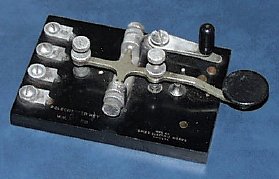
The Polechanger key has a three positon switch which allows the operator to select a polarity for a particular line. The need for switching positive or negative voltage polarities to duplex or quadruplex landline circuits led to the developement of the Polechanger Key.
Hungarian Army Key

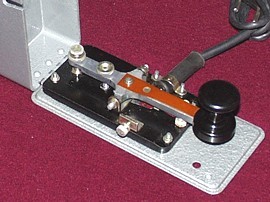
This key was new when I received it. I don't know much about it, except that it is a Hungarian Army Key.
Dittmore - Freimuth Navy Key
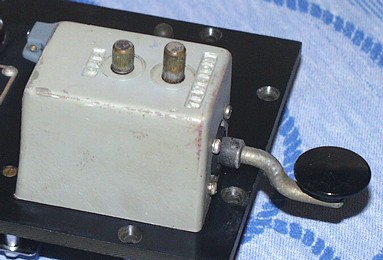
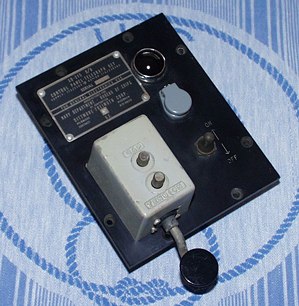
U.S. Navy ships used this key on the SB-315 B/U Control Panel, (shown above), during the 1960's and 70's. The key was made for the Department of the Navy by Dittmore-Freimuth Corp. of Milwaukee, WI under contract number N126-03948A.
Bulgarian Army Key
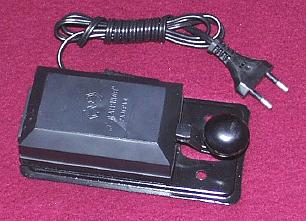
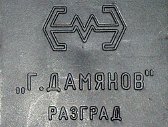
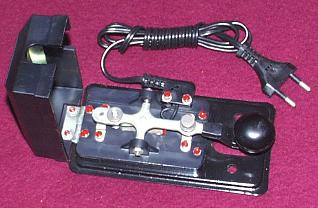
This key was made by the G. Damianov factory in the city of Razgrad. The connector is a 1 amp 220V plug, typical of the key plugs used by the Russians on Soviet Army keys. The photo in the middle is a closeup of the key cover. At the top is the DAMIANOV factory logo. Below the logo is the factory name ( G. DAMIANOV ). Bottom line is the city of manufacture, ( RAZGRAD ). All of which is printed in Cyrillic.
Czech Army Key
Post W.W.II
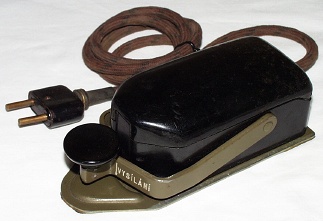

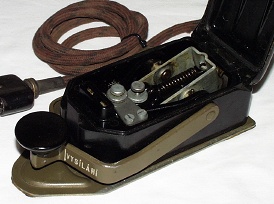
Vibroplex Code Mite

The new Vibroplex Code Mite is a very small hand
key that is easy to adjust and fun to operate.
You can see just how small this key really is in
comparison to the quarter in the photo.
Kent Hand Key
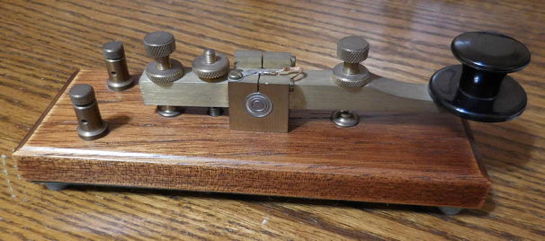
Kent Hand Key made in Preston England between 1983 to 2006.
This key was used July 8, 2021 in QSO with KG5KGU on 20 meters.
Toy Radio-Telegraph Signal Set
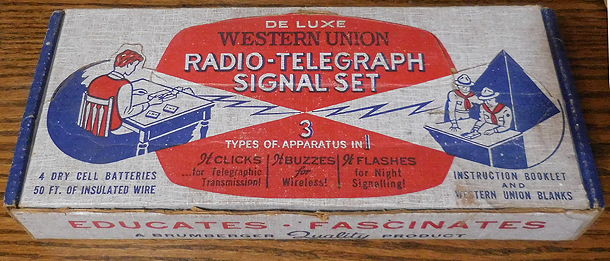
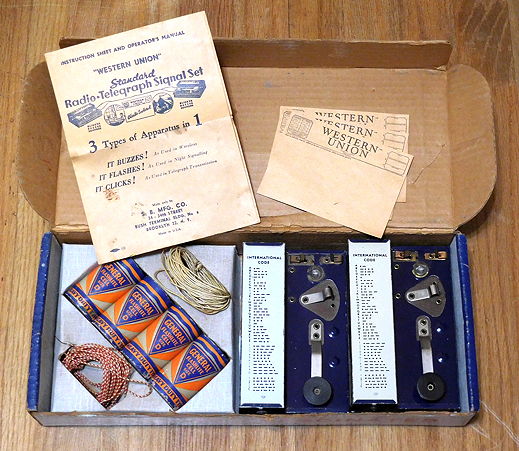
This Western Union Radio-Telegraph Signal Set was made between 1938 to 1945
by S.B. Mfg. Co., 34 - 34th Street, Bush Terminal Bldg. No 6, Brooklyn 32, N.Y.
This set is complete with the four original "D" size battery cells made by
General Dry Batteries, Inc., of Cleveland, Ohio.
1918 Vibroplex Wire Chief's Vertical - S/N 62735
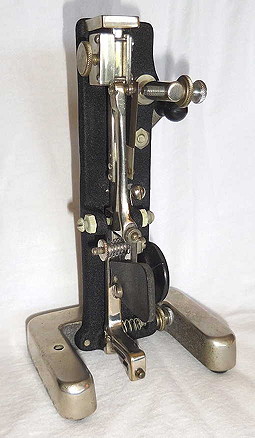
|

This Vibroplex key was made in 1918, and is the "Wire Chief's" vertical model. A small number of these keys were made to answer the telegraphers desire to have a key that took up less room on their desk.
|
1922 Vibroplex - S/N 85843
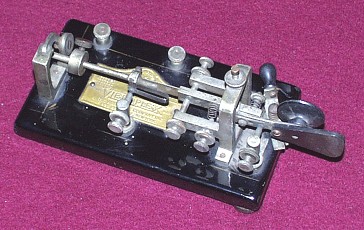
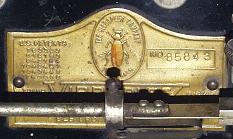
This Vibroplex key was made in 1922, and is the "Original" model with Black Japanned painted base. Some of the original gold pin striping can still be seen near the edges of the base plate. The serial number of this Vibroplex semi-automatic key is 85843 as seen on the data plate photo.
1942 Vibroplex S/N 121723
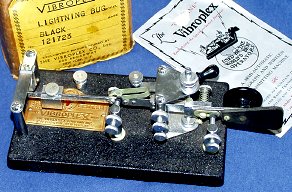

This Vibroplex key was made in 1942, and is the "Lightning Bug" model with black crackle paint. The serial number of this Vibroplex semi-automatic key is 121723 as seen on the data plate photo.
1945 Vibroplex Lightning Bug Deluxe - S/N 142556

During W.W.II, the DELUXE model Vibroplex had a grey crackle painted base and red finger pieces. The Vibroplex name plate was also made of something other than brass. This was done to conserve chrome and brass for other war materials.
1946 Vibroplex Zephyr - S/N #150108
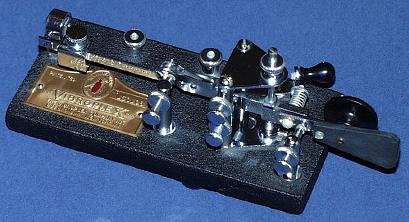

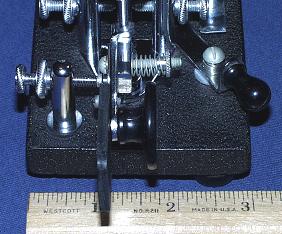
This Vibroplex Zephyr was made in 1946 as seen by the D6 data plate serial number. The Zephyr is almost identical to the Champion model. Difference between them is the Zephyr has a circuit closer and a smaller 3" wide base.
1948 Vibroplex - S/N 158554

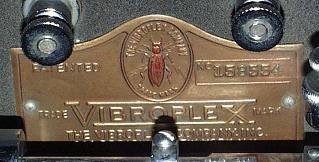
This Vibroplex key was made in 1948, and is the "Original" model with black crackle paint. The serial number of this Vibroplex semi-automatic key is 158554 seen on the data plate.
1950 Vibroplex Blue Racer Deluxe - S/N 168046
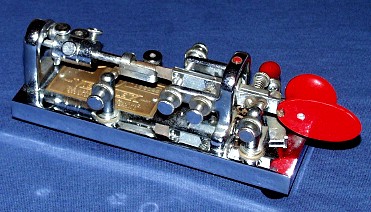
This is a Vibroplex "Blue Racer Deluxe" model made in 1950.
1954 Vibroplex Lightning Bug Deluxe - S/N 186194
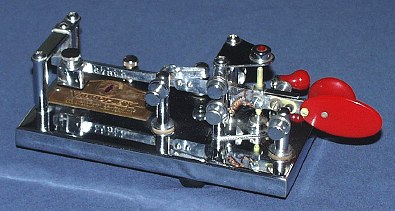
1959 Vibroplex Original Deluxe - S/N 208738

The original owner was Alan Walthers, U.S. Navy radioman 1958 to 1969. While stationed on Midway Island, during a very bad Pacific storm, he received and answered an SOS call from a Japanese ship on 500 kcs. It was January 1, 1960, and the Japanese ship was the Seifuku Maru, radio call JKNN. The ship was 600 miles north of Midway and flooding badly. Alan used this key to talk with the radio operator for an hour before he had to abandon the sinking ship. A flying boat aircraft was sent to the area and spotted the crew in life boats, but could not land as the seas were to rough. Alan said, "The Japanese operator had a very good fist, and I felt that he was very brave because he didn't screw up at all in his sending. At the end I wished him good luck before he signed off, but wished I had taken some private info from him in order to pass to his family....." The Seifuku Maru ( JKNN ) sank, and the entire crew perished in the raging storm.....
1960 Vibroplex - S/N 213484

This is the "Champion" model of the Vibroplex line of keys.
Serial number 213484 was made in 1960.
1986 Vibroplex - S/N 53908

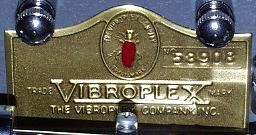
This is also a Vibroplex "Original" model, and was made in 1986. The only change made between this 1986 "Original" and the 1948 "Original" was the elimination of the circuit closer lever. The rest of the mechanism is virtually unchanged.
1990 Vibroplex - S/N 65108
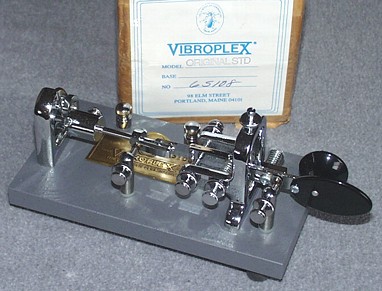
This is also a Vibroplex "Original Standard" model.
It was made in 1990 at, 98 Elm Street, Portland, Maine, 04101
Vibroplex Blue Racer 2000 - S/N 104523
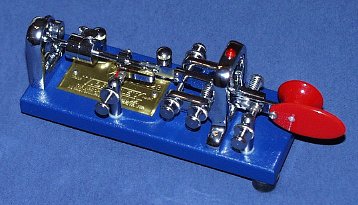
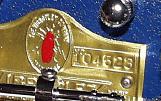
The first ten keys, 104501 to 104510, were kept for the Vibroplex factory. Serial number 104511 was the first key sold to the public, and the key pictured here was the 12th.
Hi-Mound BK-100
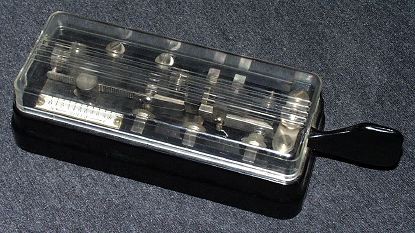
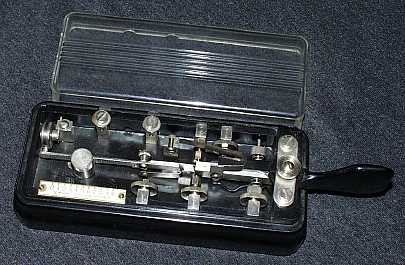
Thousands of these Semi-Automatic Keys were made during the early 50's and on into the 60's. They were made in Japan and sold here in the U.S. by Lafayette Radio, and several other retail outlets. This key was my very first semi-automatic key, or "Bug". I made many DX contacts and friends while using this key. Wish I could remember exactly when I purchased this key, but it would have been around 1969 or 1970. The plastic cover did keep a lot of dust out of the key mechanism, but had to be removed every time you wanted to make adjustments.
My first QSO using this key was with my Dad WA6CCM on 40 meters, Feb 3, 1970.
Speed-X Bug Model 114 - 500
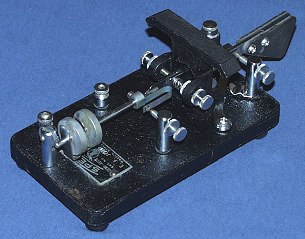

I believe this E.F. Johnson Speed-X bug was produced sometime near the transition between Les Logan and E.F. Johnson. This would date the key around 1949 to 1952. This Speed-X model has the famed Les Logan T-Bar yoke, which makes it easy to carry.
Speed-X Bug Model 114 - 520
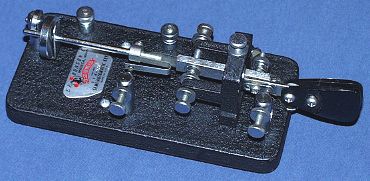
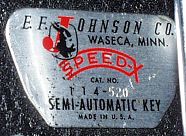
I'm not sure when this key was made, but I would guess it was sometime in the 1950's. This E.F. Johnson Speed-X key has a nice feel to it, and is a delight to use. It is somewhat lighter in weight, compared to other bugs, and needs to be held or screwed down to the desk when in use.
Lionel J-36
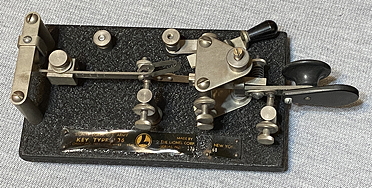

This Lionel J-36 was made by the Lionel Toy Train company in the early 1940's during W.W.II. The data plates were made from a plastic material and most of them did not survive due to the plastic becoming very brittle. This key still has a great feel when used on the air!
Vibroplex Paddle Deluxe Key S/N 257483
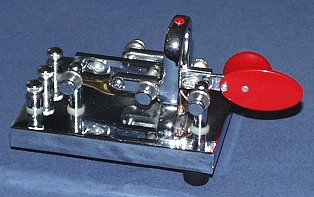
This is a Vibroplex "Deluxe" keyer paddle.
Serial number 257483, was made in 1968.
This key was use for my 1st QSO with Bert F6HKA on 18 meters, Mar 17, 2006.
Vibroplex Paddle S/N 269509
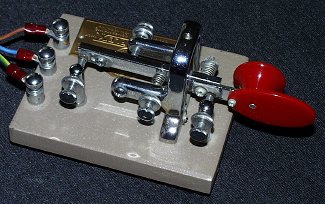
This is a Vibroplex "Standard" keyer paddle.
Serial number 269509, was made in 1972.
This key was used in QSO with Scott W5AAJ on 40 meters, Jun 16, 2020.
1987 Vibroplex "Standard" Iambic Key
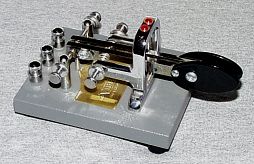
This Vibroplex, "Standard" model, Iambic Paddle was made in 1987.
This model used dual paddles and arms, with individual spring,
and contact adjustments.
Vibroplex Square Racer Deluxe
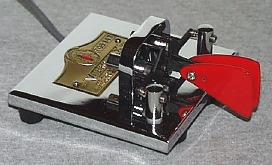
This is the NEW Vibroplex "Square Racer"
Mechanical contact adjustments combined with adjustable
magnetic tension give this key a very smooth feel.
The red finger paddles are curved slightly downward which allows
for a comfortable position for the operators hand.
This iambic keyer paddle was built in 1999.
Ham Key HK-1

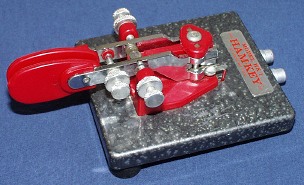
I believe these Ham Key Paddles were made sometime in the late 60's and into the 70's. They were never quite as popular as some other brands of keyer paddles. None the less, . . . they still work very well, and are a nice addition to any key collection.
Bencher BY-1 Paddle
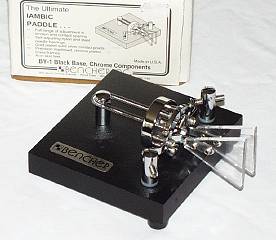
This Bencher BY-1 paddle is an Iambic type paddle and
can be adjusted for very close contact spacing.
It has gold plated solid silver contacts, and self-adjusting
nylon & steel needle bearings.
Russian ElectroInstrument KEY-8 Paddle with Keyer
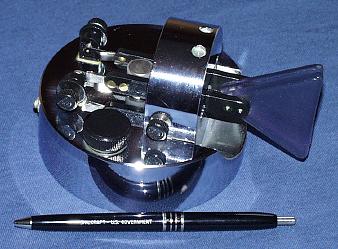
Manufactured in VORONEZH, RUSSIA by ElectroInstrument a Soviet Military contractor. The built in keyer operates on 6 to 15 volts DC, and has a speed range of 5 to 50 WPM. The large black knob on the left side of the key is the keyer speed adjust.
The KEY-8 is approximately 3.5 pounds, and is 4 inches in diameter.
Heath Kit Model HD-10 Keyer / Paddles
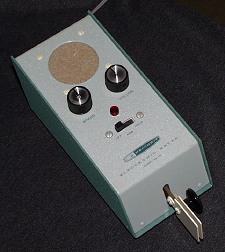
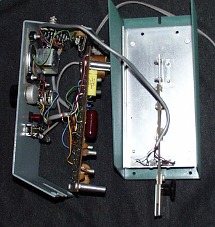
Heath Kit made a bunch of these combination Keyer and Paddle kits.
I bought this one at a ham swap meet for $1.00, including the manual!
The only draw back to this unit is the paddles have a rather odd feel.
This is due to micro switches being used for the paddle contacts.
Homebrew Paddle
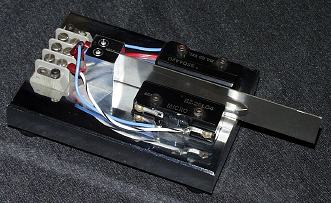
This is a keyer paddle I made around 1971.
It uses a couple of micro switches as contacts.
Not the best arrangement, but it did the job until I bought a Vibroplex paddle.
Paddlette Co. PK-1 Key
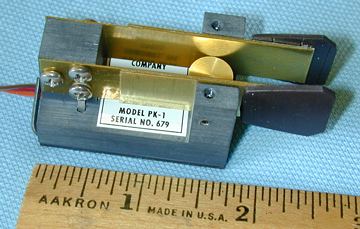
The PK-1 key is a small paddle with a good feel. Adjustments are smooth
and easy to make. It's small size, 1" by 1.75" and light weight 1.5 oz.,
makes it a good choice for back packers with QRP rigs.
If you are interested in more info on this key, try the Paddlette Co. web site at: www.paddlette.com
Autronic Paddle
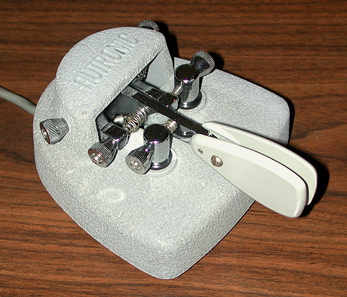
This key was made in 1960 by Electrophysics Corp.of Newport Beach, CA.
The Autronic Paddle is well built and heavy. Once properly adjusted,
it stays put on the desk and is a pleasure to operate.
Kent Twin Paddle

The Kent Twin Paddle is well built, easy to adjust,
and has a solid feel when operating.
Brown Bros CTL-B
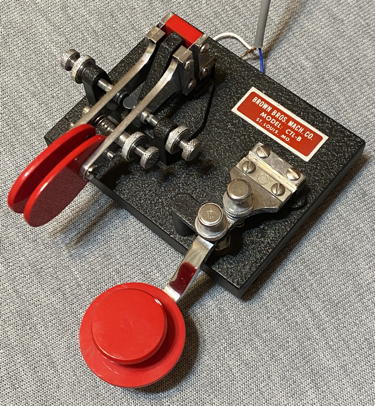
The Brown Bros duel key set is well made. The double lever paddle is
easy to adjust and can be used with iambic keyers. The straight hand
key has a solid feel when sending.
J.H. Bunnell Telegraph Relay
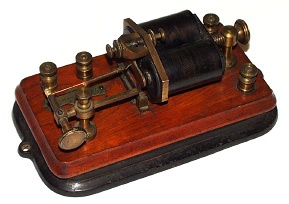
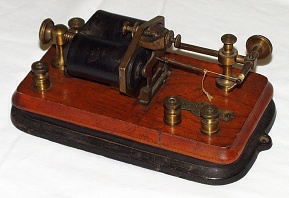

J.H. Bunnell Telegraph Relay Circa 1844 to 1881
Main Line Relay - 150 Ohm Coils. This J.H. Bunnell telegraph relay was used in the SOO LINE Railroad Station in Argonne, Wisconsin. It is original and complete, even down to the original pull-back string and spring!
Signal Electric Telegraph Relay
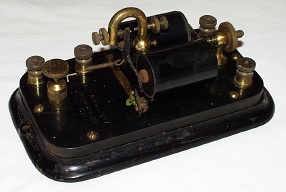
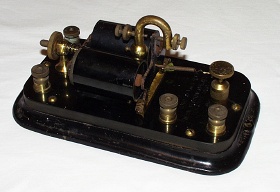

Signal Electric Mfg. Telegraph Relay Circa 1881 to 1950
Main Line Relay - 250 Ohm Coils. This telegraph relay was made by Signal Electric Company. The data marking on the relay base reads, . . . 250 OHMS 917 Signal Electric Mfg. Co. Menominee, Mich.
Western Electric Sounder
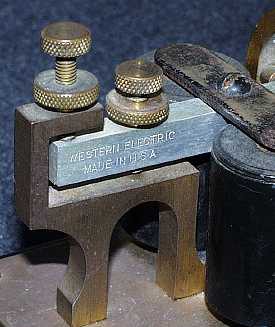
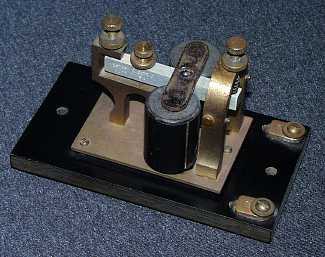
Western Electric Sounder Circa 1905 to 1920
Main Line Sounder - 20 Ohm Coils.
Electrical Supply Co. Sounder
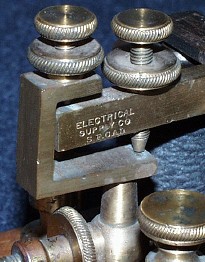
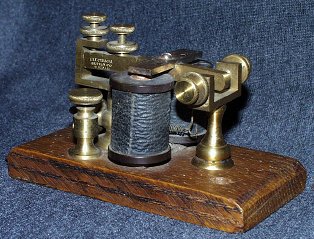
Electrical Supply Co. Sounder Circa 1848 to 1881 with 5 Ohm Coils.
Most sounders from this period used horizontally mounted springs. You can see the horizontal spring between the coils on the right photo. The left photo shows the engraving on the bar.
Western Union Telegraph Sounder

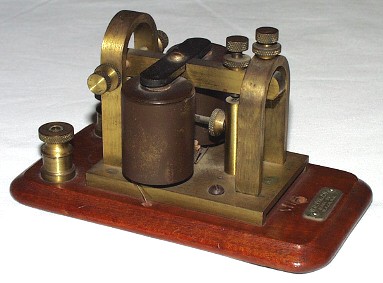
Western Union Telegraph Sounder Circa 1860 to 1881 with 4 Ohm Coils. This Western Union Telegraph Sounder was made for W.U. by Western Electric Co., N.Y.. It's rather unique design gives it a somewhat different "clack" sound as compaired to other sounders of it's time. I date this in the 1860 to 1881 time frame due to it's horizontal tension spring. This sounder would have been used on a secondary telegraph circuit keyed by a main line relay.
Foote-Pierson Western Union Sounder
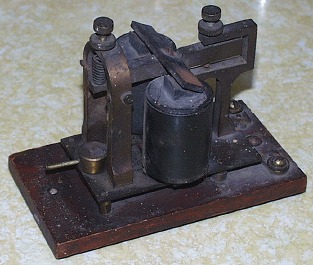
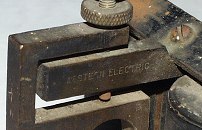
Foote-Pierson Western Union Sounder Circa 1900 to 1935
Main Line Sounder 15-B with 30 Ohm coils. This Western Electric Telegraph Co. sounder was donated to my collection by Les Wheeler. Les used to be a Land Line Telegrapher at Westwood, California. The Westwood station served the Southern Pacific, Western Pacific, and Red River Lumber Railroads in a joint operation, which also included Western Union traffic. This sounder has a very unique way to adjust the coil armature to drawbar gap. The lever on the right side controls a cam that moves the coils left and right horizontally to adjust the gap spacing.
Western Union Main Line 15-C Telegraph Sounder
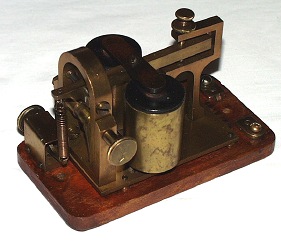
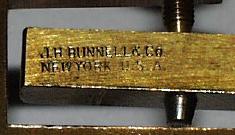

Western Union 15-C Main Line Telegraph Sounder Circa 1901 to 1930, 100 Ohms. This beautiful sounder was made for the Western Union Telegraph Company by J.H. Bunnell Co., N.Y.. "GHEGAN PATENT JULY 16, 1901", is stamped into the brass base of the sounder. This sounder uses a unique cam adjustment to set the gap spacing between the draw bar and coils. The adjusting handle can be seen in the right photo.
Western Union Telegraph Sounder
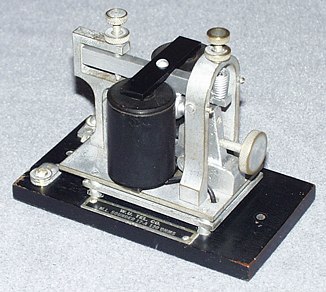
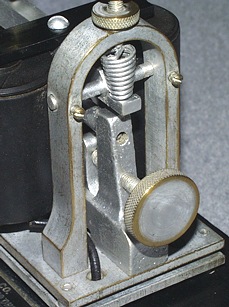
![]()
Western Union Main Line Telegraph Sounder 17-A with 120 Ohm Coils. This Western Union Telegraph Sounder is a Bunnell design. It's unique adjustment design makes it easy to adjust for varying line current.
Western Electric Telegraph Sounder 7-A

Western Electric Telegraph Sounder 7-A with 1000 Ohm Coils.

Western Union Telegraph Sounder
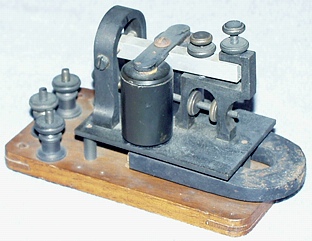
Western Union Telegraph Sounder Unknown Manufacture with 170 Ohms Each Coil.
Mesco Key On Board

Mesco Key-On-Board with 20 ohm sounder coils and Triumph style key.